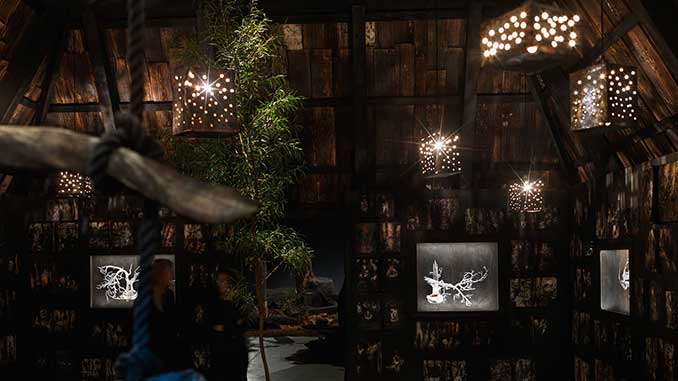 The aftermath of a devastating fire is the setting for Exodust – Crying Country, a collaboration between artist Fiona Hall and AJ King at Hobart’s Museum of Old and New Art (MONA) until Monday 17 October 2022.
The aftermath of a devastating fire is the setting for Exodust – Crying Country, a collaboration between artist Fiona Hall and AJ King at Hobart’s Museum of Old and New Art (MONA) until Monday 17 October 2022.
Inside the gallery, enormous charred stumps protrude from soot-grey earth flecked with black charcoal blocks and littered with distinctive orange clay burnt with such intensity it has fired into large clumps of crudely-formed ceramics.
Look closer, and the stumps bear the scars of centuries old logging practices: notches that once held sawyers aloft as they wielded cross-cut saws against the forest giants.
AJ King, a Bigambul / Wakka Wakka cultural practitioner, and his collaborators sourced the forest-scape from logging coupes in Tasmania’s south. The process brought together members of the local Aboriginal community with logging contractors in a rare encounter.
“We had Aboriginal people sharing knowledge of country that [the loggers] were hearing for the first time,” says King. Their exchanges are echoed in the audio recordings of First Nation’s people’s lived experience that play throughout the gallery.
Amongst the charred forest, sits a burnt-out settler’s hut clad in stringybark planks. For Hall the hut represents her “despairing vision of a little shelter from British European colonization of Australia.”
“The work I’m making these days comes from a deep level of despair with no hope,” explains Hall.
Inside, charred books splayed open, gutted and affixed to the wall reveal images of carnage, war and political disruption. They form the back drop to Split Infinitive, 2022, thirteen vitrines, in which Hall has reprised her signature ‘fish-can’ sculptures, wrought from sardine tins and aluminum cans.
In each, a downed tree, its branches and bows splintered, its roots replaced with an assortment of penises. Near the door, a single vitrine bucks this uniform reading: a tree still alive, its bow a shelter for animals, its roots a vagina.
Other items fill the hut: a possum-skin cloak made by Aunty Michelle McNamara, clapsticks made by King, a small coffin, a rope ladder, a window made of recycled plastic bottles, and a young sapling bursting through the burnt ground.
Towards the back of the gallery, a display case houses small-scale replicas of sites levelled by malevolent forces carved in bread. Putin’s missile strikes on a Ukrainian museum fashioned from an unsliced sandwich loaf; the Taliban’s made-for-TV destruction of the Bamiyan Buddhas carved from a High-Tin loaf; Isis’ partial destruction of the ancient Roman city of Palmrya constructed from segments of sliced white bread. In Hall’s hands, bread has rendered these aggressive actions as futile as bread is fragile.
Despite the bleakness that shrouds Hall’s art-making process, her work is intrinsically hopeful: with modest materials she tackles big issues and wields great power. While King offers us hope for the future. “The way forward,” he says, is to listen to the people who have “lived sustainably for thousands of years.”
Fiona Hall and AJ King: Exodust – Crying Country
Museum of Old and New Art (MONA), 655 Main Road, Berriedale (Hobart)
Exhibition continues to 17 October 2022
Entry fees apply
For more information, visit: www.mona.net.au for details.
Image: Fiona Hall and AJ King, Exodust – Crying Country (Installation View) – photo by Jesse Hunniford | courtesy of Museum of Old and New Art, Hobart
Review: Tim Stone
